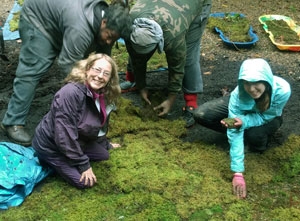
If I told you there’s something green sparkling in the February sunlight just outside your door, you might be tempted to take a look. Don’t be disappointed if all you find is moss. It sometimes pays to notice the familiar.
According to professional moss grower Annie Martin, who operates Mountain Moss (www.mountainmoss.com) in Brevard, North Carolina, these plants have antifreeze. In her book, The Magical World of Moss Gardening (Timber Press, 2015), Martin explains that ancient mosses developed phenolic compounds that have seen the plants through more than a few ice ages and continue to do so in our more temperate times. (Martin is pictured here at her moss farm. Photo courtesy of Annie Martin.)
As a result, moss doesn’t automatically go to sleep in fall.
“As long as the surface is moist and exposed, moss photosynthesizes all year,” says Martin. “In winter, the plants absorb bright filtered light below bare tree limbs. They even photosynthesize under snow.”
Moss doesn’t mind moving to frozen or semi-frozen surfaces as long as the surface is rough.
A few years ago, Laurie Silvia of Old Lyme noticed the mosses in her yard and began to experiment with them. She always liked the look of velvet green intermingled with stepping stones.
“I picked up moss in small tufts, scratched the sand out of the crevices in the front walk, and tucked the tufts in between the stones,” says Silvia. Never having planted moss, she was pleasantly surprised by how easily it worked. Then she got another surprise. “I found I could add moss any time of year, as long as there wasn’t snow on the ground,” she says.
Silvia concluded that this low-growing velvet greenery was her ticket to a simpler yard care routine.
“We tried to grow grass for years. Finally, in frustration, we stopped adding seed, lime, and fertilizers,” she says. “Nature took over. Now, the area is mossy all the time.”
